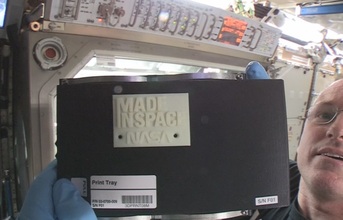
The 3-D Printing in Zero-G Technology Demonstration on the space station aims to show additive manufacturing can make a variety of 3-D printed parts and tools in space.
The first object 3-D printed in space, the printhead faceplate, is engraved with names of the organizations that collaborated on this space station technology demonstration: NASA and Made In Space, Inc., the space manufacturing company that worked with NASA to design, build and test the 3-D printer. Made In Space is located on the campus of NASA's Ames Research Center in Moffett Field, California.
"We chose this part to print first because, after all, if we are going to have 3-D printers make spare and replacement parts for critical items in space, we have to be able to make spare parts for the printers," Werkheiser said.
"If a printer is critical for explorers, it must be capable of replicating its own parts, so that it can keep working during longer journeys to places like Mars or an asteroid. Ultimately, one day, a printer may even be able to print another printer."
Made In Space engineers commanded the printer to make the first object while working with controllers at NASA's Payload Operations Integration Center in Huntsville. As the first objects are printed, NASA and Made In Space engineers are monitoring the manufacturing via downlinked images and videos. The majority of the printing process is controlled from the ground to limit crew time required for operations.
"The operation of the 3-D printer is a transformative moment in space development," said Aaron Kemmer, chief executive officer of Made In Space. "We've built a machine that will provide us with research data needed to develop future 3-D printers for the International Space Station and beyond, revolutionizing space manufacturing. This may change how we approach getting replacement tools and parts to the space station crew, allowing them to be less reliant on supply missions from Earth."
The first objects built in space will be returned to Earth in 2015 for detailed analysis and comparison to identical ground control samples made on the flight printer after final flight testing earlier this year at, NASA's Marshall Center prior to launch. The goal of this analysis is to verify that the 3-D printing process works the same in microgravity as it does on Earth.
By Bill Hubscher
International Space Station Program Science Office
NASA's Marshall Space Flight Center


























